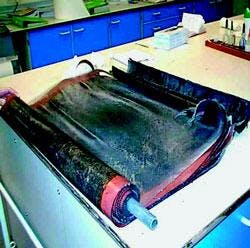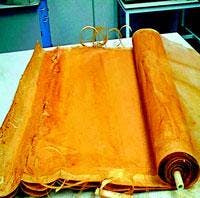Troubleshooting RO systems solves biofouling
By: Kevin Williams
Reverse osmosis and other membrane systems are widely accepted as robust and reliable technology. Indeed, recent awards for desalinated water production from seawater reverse osmosis plants at US$ 0.53 per cubic metre easily validate claims that membrane desalination is economically viable. Operational problems from membrane fouling, however, can increase performance costs of membrane technology. Attendees of most water conferences will notice that one major pre-occupation of engineers working in plants using membrane facilities is fouling.
Membrane fouling often involves a combination of foulants, including biofilm, calcium and iron. Biological fouling is most common. According to a study conducted by Max Fazel of Ondeo Nalco UK, 50% of 150 membranes received for autopsy were biologically fouled and only 4% had calcium scale formation. This may indicate that potential problems of calcium deposition are well understood and that the use of antiscal-ants is well accepted.
Biofouling and adsorbed organics accounted for, respectively 33.5% and 11.4% of the decline in performance of RO desalination plants studied by Prof. Dr. Gamal Khedr of Saudi Industries for Desalination Membranes & Systems in Saudi Arabia. He highlighted that the low incidence of scale formation with silica scale/fouling was 10% and other inorganic scale and fouling was 5%. Again, this low percentage suggests that the potential problems of scale formation are understood and treated.
Biofouling
Biofouling describes the foulant layer when it consists of bacterial cells and the external polysaccharide, EPS, substances that they secrete, which provide protection and structure. Water content of the biofilm is in excess of 85% and bacterial colonies range between 106 to 108 colony forming units (cfu)/ml. Many membranes tested do have measurable bacterial colonies on the membrane surface, and at low levels of 103 to 104 cfu/ml, their effect on the membrane and system performance is minor. These systems operate below the "Pain Threshold"; the bacteria exist in the system but do not cause operational problems.
Factors affecting membrane biofouling are a combination of operational conditions, including temperature and standby time, but the key factor is the availability of a food source for bacteria - nutrients. Nutrients can be conveniently measured as Assimilable Organic Carbon (AOC). Literally, this is organic carbon, which is available to bacteria. The AOC test is a digestion using bacteria and the humic acid molecule. Other large organic molecules are too big so they are not "available." Perhaps this can be thought of as "more than a mouthful and there is no snacking" so these large molecules are unaffected by the bacteria.
Practical steps can be taken to minimise the formation of biofilm. An oxidising biocide, usually chlorine, is used as a disinfectant to kill bacteria during pre-treatment stages of the membrane system. If the system uses polyamide RO membranes, they require protection against chlorine so a neutraliser, such as sodium bisulphite, is needed.
From practical experience, this plan fails for two reasons. First, chlorine does kill a substantial proportion of bacteria but it also breaks cell walls and releases cell contents into water. This makes available the carbohydrates and proteins that were previously locked with the cell. This is measured as an increase of AOC. Second, large organic molecules are degraded by chlorine and become assimilable, increasing AOC.
Mohamed O. Saeed of Sea Water Conversion Corporation in Saudi Arabia observed that generation times, a way to monitor bacterial growth rates, were low in chlorinated systems. He noticed that generation times were significantly lower (i.e. higher growth rates) at a point downstream of chlorine neutralisation. This is due to an increase in AOC. Biocide removal leads to a "feeding frenzy" in which surviving bacteria have little competition and many resources. This observation begs the question "Where will biofouling occur?" If chlorine is used, the dechlorination point is upstream of the membranes. This means that the feeding frenzy occurs in membranes, which have large surface areas, where established sessile bacterial populations grow rapidly.
The continuous use of disinfectants, including non-oxidising biocides such as glutaraldehydes and isothiozolines, also affects the nature of biofilm formation increasing the ratio of EPS/bacteria. This can lead to the formation of a more problematic biofilm affecting system pressures and flux. Avoiding or reducing the rate of disinfection can improve significantly operational benefits. Throughout the pre-treatment system, bacteria are growing and removing nutrients from the water so bacteria within the membrane must compete for limited nutrients, which can lead to limited biofilm formation.
Systems can operate without chlorine and not create biofouling problems in feed waters with low AOC. Feed waters with high AOC can also be used with minimal biofouling when the pretreatment system is designed and operated to maximise the reduction of AOC. PermaCare's experience reflects other industry experiences. For example, Ali B. Hamida of the Dupont Company reported the effectiveness of a treatment regime without continuous use of chlorine.
Regional case histories
A water company in Northern Europe uses an RO system to treat upland water for drinking water production but the system was failing, indicated by increased pressures and reduced permeate production. A membrane autopsy discovered that the cause of the performance problem was biofouling. Bacterial counts of 108 cfu/ml on the membrane surface were recorded. The foulant water content of 92% was typical. The company used the system CIP weekly to restore performance. The water supply had a low AOC, but the antiscalant then being dosed may have caused more biofouling.
PermaCare suggested that its product PermaTreat PC-191™ be dosed, which significantly improved system performance. The reduction of AOC was sufficient to moderate bacterial growth rates to below the pain threshold and the biofouling problem disappeared. Consequently, the water company reduced cleaning to once per six months, reduced labour and chemical operating costs and improved plant performance.
Significant differences between chemicals used to prevent scaling affect their ability to promote growth of microorganisms. Antiscalant could increase AOC, the nutrient supply, sufficiently to encourage biofilm development so that it becomes a problem. Symptoms include an increasing pressure drop across the membrane as the hydrodynamic drag increases and the change of salt passage as the biofilm affects the boundary layer.
An RO system in the Middle East that produces permeate for potable and industrial use required frequent cleaning. Due to logistical problems, cleanings were carried out using commodity chemicals every three to four weeks. A borehole supplied the feed water, which was stored in a break tank after chlorination. The water was pumped through a carbon filter, media filters and 10-µm cartridge filters into the RO system. Sodium bisulphite (SBS), to neutralise chlorine and an antiscalant were dosed prior to the cartridge filters.
Autopsies proved that the system required frequent cleaning due to biofouling. Troubleshooting the system requires a holistic approach, including the membranes and pre-treatment. PermaCare recommended -
• Halt continuous chlorination of water;
• Change antiscalant to PermaTreat PC-191trademark, a low nutrition product
Use proprietary cleaning chemical on revised regime.
These changes provided immediate benefits to the system operator. Cleaning became less frequent and more effective; however the system now operates without chlorine or SBS. Cleaning is carried out between two to three times a year.
Trouble shooting is, for the author, the most interesting phase of the technical support process. This is when one has to consider the unbelievable and the improbable in addition to the obvious to find a practical explanation for circumstances based on collected operational data. The best phase of the process is realising that the recommended corrective actions worked and worked well!
Author's note
Kevin Williams is the market development manager of the PermaCare Brand of Ondeo-Nalco and is based in Farnham, United Kingdom.




